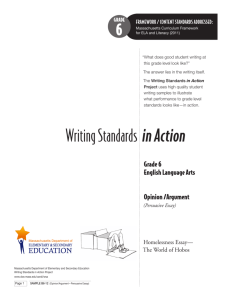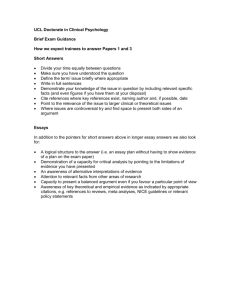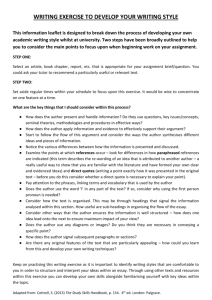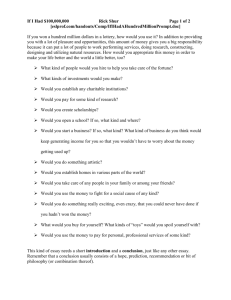grade 6 - Massachusetts Department of Education
advertisement
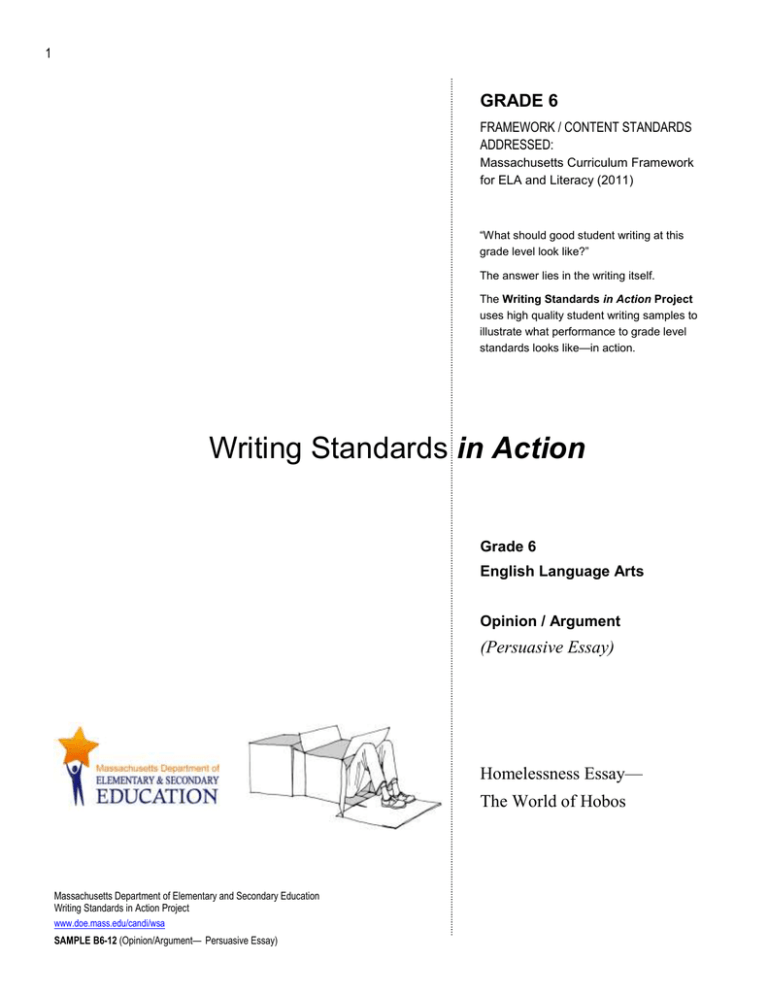
1 GRADE 6 FRAMEWORK / CONTENT STANDARDS ADDRESSED: Massachusetts Curriculum Framework for ELA and Literacy (2011) “What should good student writing at this grade level look like?” The answer lies in the writing itself. The Writing Standards in Action Project uses high quality student writing samples to illustrate what performance to grade level standards looks like—in action. Writing Standards in Action Grade 6 English Language Arts Opinion / Argument (Persuasive Essay) Homelessness Essay— The World of Hobos Massachusetts Department of Elementary and Secondary Education Writing Standards in Action Project www.doe.mass.edu/candi/wsa SAMPLE B6-12 (Opinion/Argument— Persuasive Essay) 2 GRADE 6 FRAMEWORK / CONTENT STANDARDS ADDRESSED: Massachusetts Curriculum Framework for ELA and Literacy (2011) Background Information Writing Sample Title: Homelessness Essay—The World of Hobos Text Type and Purpose: Opinion / Argument Grade level/Content area: Grade 6 English Language Arts Type of Assignment: Persuasive Essay Standards Addressed: (W.6.1), (W.6.4), (L.6.2), (L.6.3), (L.6.5) See descriptions of these standards in the right column of the next page. Highlights: This sample of student work meets grade level standards. It demonstrates the following attributes of effective writing. STANDARDS-BASED COMMENTARY The student writing sample that follows includes standards-based commentary. The commentary in this column describes how the writing meets the standards in the Massachusetts Curriculum Framework for English Language Arts and Literacy (2011) and other content frameworks when applicable. Understanding the Standards-Based Commentary 1. Grade-specific standards addressed are: Listed in the column to the right of student work by strand, grade, and number (or number and letter, where applicable) Marked by a letter code (in parenthesis), also in the column to the right of the student work EXAMPLE: (A) The sample: Introduces an empathetic claim, contextualized in a vivid and empathetic manner Elaborates on the claim with clear, convincing reasoning and evidence Creates with a variety of linking words, phrases, and clauses a logical, cohesive progression of ideas Establishes and maintains an effective style Makes strategic use of precise language to express ideas concisely Varies sentence patterns to enhance style Uses words and phrases to indicate an enthusiastic tone Provides a strong conclusion that reinforces the claim with figurative language 2. The letter codes with a letter-coded arrow beneath each standard in the right column: Are of the same letter code as the letter in parenthesis that marks the standard being addressed Mark standards-based commentary related to the standard being addressed Appear in alphabetical order EXAMPLE: A1> 3. Corresponding letter coded arrows within the text: Set off sections of student work to which commentary applies Do not necessarily appear in alphabetical order—but where evidence of a particular standard exists Massachusetts Department of Elementary and Secondary Education Writing Standards in Action Project www.doe.mass.edu/candi/wsa SAMPLE B6-12 (Opinion/Argument— Persuasive Essay) EXAMPLE: (begin>) section (<end) 3 GRADE 6 FRAMEWORK / CONTENT STANDARDS ADDRESSED: Massachusetts Curriculum Framework for ELA and Literacy (2011) Instructional Practices: The teacher used the following practices: Classroom analysis of exemplars to demonstrate features of effective opinion/argument writing Modeling of various organizational possibilities Frequent teacher/student interaction at each step of the writing process Writing Standards: Grade 6, Standard 1 (W.6.1) Write arguments to support claims with clear reasons and relevant evidence. EXAMPLES: (A) (B) (C) (D) Writing Standards: Grade 6, Standard 4 (W.6.4) Produce clear and coherent writing in which the development, organization, and style are appropriate to task, purpose, and audience. EXAMPLE: Assignment Description: Students were asked to propose a solution to a local, state, or national problem. Relying on personal experience, they were to convince readers of the serious nature of the problem and the practicality of the solution. Intended Audience: Teacher, peers Time: 4 class periods Writing Process: Alone; in class; pre-writing; organizing; drafting; revising; selfediting; peer-editing/peer response; teacher feedback Materials: Exemplars, graphic organizers, persuasion map, teacher-made handouts, language arts text Please note: The samples may contain inaccuracies in wording and content or shortcomings in the use of standard English conventions. Massachusetts Department of Elementary and Secondary Education Writing Standards in Action Project www.doe.mass.edu/candi/wsa SAMPLE B6-12 (Opinion/Argument— Persuasive Essay) (E) Language Standards: Grade 6, Standard 2 (L.6.2) Demonstrate command of the conventions of standard English capitalization, punctuation, and spelling when writing. EXAMPLE: (F) Language Standards: Grade 6, Standard 3 (L.6.3) Use knowledge of language and its conventions when writing, speaking, reading, or listening. EXAMPLE: (G) (H) Language Standards: Grade 6, Standard 5 (L.6.5) Demonstrate understanding of figurative language, word relationships, and nuances in word meanings. EXAMPLE: (I) 4 GRADE 6 FRAMEWORK / CONTENT STANDARDS ADDRESSED: Massachusetts Curriculum Framework for ELA and Literacy (2011) Grade 6—Opinion / Argument STANDARDS-BASED COMMENTARY: : Understanding the Standards-Based Commentary In this sample… The writer argues in favor of increasing the number of homeless shelters in Boston. A logical progression of ideas incorporates convincing reasoning and evidence, made cohesive with a variety of transitional elements. Precise language and varied sentence types clarify complex ideas and create a consistent style and tone that reflect empathy for the homeless and enthusiasm for the claim. The essay concludes with figurative language that crystallizes the argument, giving it added impact. Notwithstanding somewhat formulaic organization, this sample is an effective effort at persuading the reader of the wisdom the writer’s claim. The student writing sample that begins on this page includes in this column standards-based commentary describing how the writing meets the standards in the Massachusetts Curriculum Framework for English Language Arts and other content frameworks, when applicable. Where they apply, substandards marked by letters are included. Evidence for the commentary is noted in the text of the student writing using paired letter-coded arrows and colored highlighting. For example: A1> Marks the beginning and <A1 marks the end of the relevant section, which is also highlighted. Please note that these labeled items in the text do not necessarily appear in alphabetical order. ---------------------------------------------------- Homelessness Essay The World of Hobos Writing. Grade 6, Standard 1 (A) W.6.1.a Introduce claim(s) and organize the reasons and evidence clearly. Hobos! Your first thought would probably be “Say, What?” or “Wah?”. C1>Then you might be imagining<C1 what a hobo might be like. A1>Some people may think of them as Massachusetts Department of Elementary and Secondary Education Writing Standards in Action Project www.doe.mass.edu/candi/wsa SAMPLE B6-12 (Opinion/Argument— Persuasive Essay) A1> Examples: 1 The writer defines the plight of the homeless in a vivid, empathetic manner (Some people may think of them as broke bums who stay behind a Dunkin’ Donuts or in front of a 7-11. Others may think hobos as awesome and cuddly people who are there for our entertainment, begging for cash. The reality is that they’re really people like you and me, misunderstood and treated unfairly by society.). 5 GRADE 6 FRAMEWORK / CONTENT STANDARDS ADDRESSED: Massachusetts Curriculum Framework for ELA and Literacy (2011) broke bums who stay behind a Dunkin’ Donuts or in front of a 7-11. Others may think hobos as awesome and cuddly people STANDARDS-BASED COMMENTARY: : who are there for our entertainment, begging for cash. G>The Writing. Grade 6, Standard 1 (continued) reality is that they’re really people like you and me, misunderstood and treated unfairly by society.<A1 <G C1>A2> One simple thing to solve this is<C1 to create more A2> Examples: 1 The writer concisely proposes a solution for homelessness (One simple thing to solve this is to create more homeless shelters in Boston.) A3> Examples: 1 homeless shelters in Boston. <A2 H> Little do you know <H that A3>it could create less crime, provide jobs for many, and how we could all easily become homeless in a second. <A3 Massachusetts Department of Elementary and Secondary Education Writing Standards in Action Project www.doe.mass.edu/candi/wsa SAMPLE B6-12 (Opinion/Argument— Persuasive Essay) The writer provides an organizational framework by specifying several benefits of the proposed solution (...it could create less crime, provide jobs for many, and how we could all easily become homeless in a second.). 6 GRADE 6 FRAMEWORK / CONTENT STANDARDS ADDRESSED: Massachusetts Curriculum Framework for ELA and Literacy (2011) C2> Now, I know you are probably wondering what crime has to do with a homeless shelter. <C2 H> B1>The truth is <H that like any person, homeless people can get fed up with asking for money and can resort to more desperate measures. G> Valuables and food can be stolen for money or survival. <G C1> So, like any robbery, <C1 police will have to respond which can distract them from doing other important things. C1> Shelters come in to this because <C1 when people are taken in, they are usually supplied with most things needed for living, such as a bed and food.<B1 C1> B2>This means that <C1 there is less need for hobos or the homeless to steal necessities. <B2 Massachusetts Department of Elementary and Secondary Education Writing Standards in Action Project www.doe.mass.edu/candi/wsa SAMPLE B6-12 (Opinion/Argument— Persuasive Essay) STANDARDS-BASED COMMENTARY: : Writing. Grade 6, Standard 1 (continued) (B) W.6.1.b Support claim(s) with clear reasons and relevant evidence, using credible sources and demonstrating an understanding of the topic or text. B1> Examples: 1 The writer constructs a logical, fairly easy to follow progression of ideas to give credence to each specified benefit of the proposed solution (The truth is that like any person, homeless people can get fed up with asking for money and can resort to more desperate measures. Valuables and food can be stolen for money or survival. So, like any robbery, police will have to respond which can distract them from doing other important things. Shelters come in to this because when people are taken in, they are usually supplied with most things needed for living, such as a bed and food... folks can usually jump to thinking that they were just fools that gambled too much (even I used to think that). If you think about it, though, what the Massachusetts economy is like, it would not be surprising for someone to lose a job. This can force someone to sell or just lose their house completely... What I’m talking about is you, yourself, and how we could all be homeless in a second. Plus, adults, what if you had children? Sure, I bet a fully-grown adult would know how to take care of themselves for a while on the street, but a child or a baby would have no means to keep themselves warm or know how to search for food.). 7 GRADE 6 FRAMEWORK / CONTENT STANDARDS ADDRESSED: Massachusetts Curriculum Framework for ELA and Literacy (2011) C2> Another cause of crime increase and people being homeless is because of job loss. clothed, homeless people, B1> <C2 When people see tattered Writing. Grade 6, Standard 1 (continued) folks can usually jump to thinking that they were just fools that gambled too much (even I used to think that). C1> If you think about it, though, <C1 STANDARDS-BASED COMMENTARY: : what the Massachusetts economy is like, it would not be surprising for someone to lose a job. G>This can force someone to sell or just lose their house completely. <B1 <G C1>B2>However, with B2> Examples: 1, 2, 3 The writer’s straightforward progression of ideas leads to several conclusions to buttress the overarching argument (This means that there is less need for hobos or the homeless to steal necessities... However, with more shelters, it gives these people somewhere to go where they can start small jobs to save money and get back on their feet... The situation could even lead to illness and with no money, little kids can die if left with an untreated illness.). more shelters, <C1 it gives these people somewhere to go (C) where they can start small jobs to save money and get back on their feet. <B2 W.6.1.c Use words, phrases, and clauses to clarify the relationships among claim(s) and reasons. C1> Examples: 1, 2, 3, 4, 5, 6, 7, 8 The writer creates cohesion within paragraphs with a variety of transitional elements (Then you might be imagining... One simple thing to solve this is... So, like any robbery... Shelters come in to this because... This means that... If you think about it, though... However, with more shelters... , or...). C2> Examples: 1, 2, 3, 4 Massachusetts Department of Elementary and Secondary Education Writing Standards in Action Project www.doe.mass.edu/candi/wsa SAMPLE B6-12 (Opinion/Argument— Persuasive Essay) The writer provides a variety of transitions from one paragraph to the next by referring to relevant ideas from the introduction (Now, I know you are probably wondering what crime has to do with a homeless shelter... Another cause of crime increase and people being homeless is because of job loss... What I’m talking about is you, yourself, and how we could all be homeless in a second... So, this would be why and how shelters can benefit you...). 8 GRADE 6 FRAMEWORK / CONTENT STANDARDS ADDRESSED: Massachusetts Curriculum Framework for ELA and Literacy (2011) H> Still, after all this, <H we’ve been talking about other people, but what about right now. C2> B1>What I’m talking about is you, yourself, and how we could all be homeless in a second. <C2 Plus, adults, what if you had children? Sure, I bet a fully-grown adult would know how to take care of themselves for a while on the street, but a child or a baby would have no means to keep themselves warm or know how to search for food. <B1 B2>The situation could even lead to illness and with no money, little kids can die if left with an untreated illness. <B2 STANDARDS-BASED COMMENTARY: Writing. Grade 6, Standard 1 (continued) (D) W.6.1.e Provide a concluding statement or section that follows from the argument presented. D> Examples: 1 The strong concluding statement refers to broad contours of the argument that encapsulate it and reinforce a dramatic call to action (So, this would be why and how shelters can benefit you, and maybe next time you see someone out, homeless, on the street, you might realize that could someday be a neighbor, a friend, or you! Even now, while you’re reading this, a shelter in the world could be helping someone get their life back. So, what are you waiting for? Now that you know about these reasons, you can try help make more shelters in Boston and give more people a chance. For all you know, you could be helping someone that could be the world’s next Bill Gates!). Writing. Grade 6, Standard 4 (E) W.6.4 Produce clear and coherent writing in which the development, organization, and style are appropriate to task, purpose, and audience. E> Overall Text Reference The writer makes an enthusiastic argument with a logical, fairly easy to follow progression of ideas enhanced by convincing details. Note: Comment refers to the piece as a whole rather than a specific example within the text. Massachusetts Department of Elementary and Secondary Education Writing Standards in Action Project www.doe.mass.edu/candi/wsa SAMPLE B6-12 (Opinion/Argument— Persuasive Essay) 9 GRADE 6 FRAMEWORK / CONTENT STANDARDS ADDRESSED: Massachusetts Curriculum Framework for ELA and Literacy (2011) D> C2> So, this would be why and how shelters can benefit you, <C2 and maybe next time you see someone out, homeless, on the street, you might realize that could someday be a neighbor, a friend, or you! G> C1> Even now, <C1 while you’re reading this, a shelter in the world could be helping STANDARDS-BASED COMMENTARY: Language. Grade 6, Standard 2 (F) L.6.2 Demonstrate command of the conventions of standard English capitalization, punctuation, and spelling when writing. F> Overall Text Reference someone get their life back. H> So, what are you waiting for? <G <H Now that you know about these reasons, you can try help make more shelters in Boston and give more people The writer’s sophisticated control of standard English capitalization, punctuation, and spelling enhances the clarity of this sample. Note: Comment refers to the piece as a whole rather than a specific example within the text. a chance. H>For all you know, <H I>you could be helping someone that could be the world’s next Bill Gates! <D <I Language. Grade 6, Standard 3 (G) L.6.3.a Vary sentence patterns for meaning, reader/listener interest, and style. G> Examples: 1, 2, 3, 4 END OF WRITING SAMPLE Massachusetts Department of Elementary and Secondary Education Writing Standards in Action Project www.doe.mass.edu/candi/wsa SAMPLE B6-12 (Opinion/Argument— Persuasive Essay) The writer uses a variety of sentence types to clarify ideas and enhance reader interest (The reality is that they’re really people like you and me, misunderstood and treated unfairly by society... Valuables and food can be stolen for money or survival... This can force someone to sell or just lose their house completely... Even now, while you’re reading this, a shelter in the world could be helping someone get their life back. So, what are you waiting for?). 10 GRADE 6 FRAMEWORK / CONTENT STANDARDS ADDRESSED: Massachusetts Curriculum Framework for ELA and Literacy (2011) STANDARDS-BASED COMMENTARY: Language. Grade 6, Standard 3 (continued) (H) L.6.3.b Maintain consistency in style and tone. H> Examples: 1, 2, 3, 4, 5 The writer makes purposeful use of appropriate words and phrases to indicate an enthusiastic tone (Little do you know... The truth is... Still, after all this... So, what are you waiting for...? For all you know...). Language. Grade 6, Standard 5 (I) L.6.5 Demonstrate understanding of figurative language, word relationships, and nuances in word meanings. I> Examples: 1 The writer heightens the effect of the argument by concluding it with a meaningful allusion to a well-known contemporary figure (... you could be helping someone that could be the world’s next Bill Gates!). END OF COMMENTARY Massachusetts Department of Elementary and Secondary Education Writing Standards in Action Project www.doe.mass.edu/candi/wsa SAMPLE B6-12 (Opinion/Argument— Persuasive Essay)

